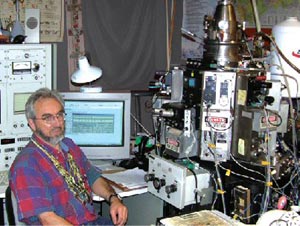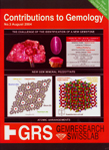 |
|
Fig.P15
Example of an Electron Microprobe. University
of New Orleans, USA (A.U. Falster).
Explanation
of method. The
method is used to analyze the chemical composition.
For analytical purposes, the analyzed mineral
must be coated with an electron-conducting layer
and positioned in a highly evacuated vacuum
chamber (1). The mineral is bombarded by electrons,
which have previously been produced and accelerated
in an electron gun (2).The different atoms in
the mineral react to the impacting electrons
by creating signals. These signals include X-rays,
which can be detected by various kinds of detectors,
such as WDS (3). From the responding signals,
the chemical composition can be determined,
providing standard materials (materials of known
composition or "Probe Standards")
are analyzed for comparison. Light elements
such as beryllium or lithium are determined
by other methods |








